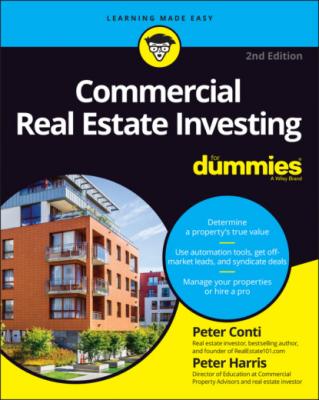Commercial Real Estate Investing For Dummies. Peter Harris
Чтение книги онлайн.
Читать онлайн книгу Commercial Real Estate Investing For Dummies - Peter Harris страница 19

FIGURE 3-1: The Commercial Property Evaluator is a tool that helps you evaluate a property’s worth. It’s available on CommercialQuickStart.com.
Because cap rates are higher or lower depending where you are investing, and can change over time, you can adjust the cap rate you prefer to use in your market. Any good commercial broker can help you determine which cap rate to use for your market. After you decide on this, make sure to use the same cap rate to value every property in the same class. You can fill in the cap rates for your market in Table 3-1.
TABLE 3-1: Cap Rates
| Property Class | Typical Cap Rate | Cap Rate for Your Market |
|---|---|---|
| Class A | 3.5 to 4.5 | |
| Class B | 5.0 to 6.0 | |
| Class C | 6.5 to 7.5 |
The Commercial Property Evaluator will determine the leased up, stabilized value of the property for you using the following default settings, which is what we are currently using for most Class C apartment buildings:
5% vacancy
45% expenses
.07 cap rate
If you’d like a look under the hood, Table 3-2 displays the formulas used by the Commercial Property Evaluator along with some actual numbers from the 50 unit “Courtside Apartments” so you can see how this works.
TABLE 3-2: Courtside Apartments Example
| Step | Description | Courtside Apartments | Shortcut to Next Step |
|---|---|---|---|
| One | Total Monthly Income | $80,000 | Get Annual Income (Multiply × 12) |
| Two | Total Annual Income | $960,000 | Remove 5% Vacancies (Multiply × .95) |
| Three | Effective Gross Income | $912,000 | Remove 45% Expenses (Multiply × .55) |
| Four | Net Operating Income (NOI) | $501,600 | Apply Cap Rate (Divide by .07) |
| Five | Property Value | $7,165,714 |
Using the online version our mentoring clients also enter the market rents to come up with a “Proforma” value so we know what the property will be worth when we increase the rents up to market value. To do this yourself with the Commercial Property Evaluator here in the book, take an extra step and enter the market rents instead of the actual rents. This will give you the proforma value of the property.
We then compare these three values to give us an indication of what the upside looks like and whether it’s worth our time to pursue the deal:
Asking price from the seller
Actual property value
Proforma value
You can use the Commercial Property Evaluator to quickly separate deals into three piles so that you don’t waste your time on properties where the seller is simply asking way too much for the property. In most cases this is a pretty good clue that they aren’t motivated. They’re hoping that someone comes along who’s willing to pay more for the property than it’s actually worth.
Diving Deeper into Property Valuation
The dictionary definition of the word analysis is “a separation of the whole into its component parts.” So, during this deep dive we break down any property analysis into its component parts:
Income
Expense
Debt
That’s it. We take a look at the income information. Then we take a look at the expenses. And finally, we add a loan or mortgage to the overall picture. We combine them to come to a conclusion as to whether this deal makes money. Analysis made simple.
Analyze and compile the income part
Analyze and compile the expense part
Analyze and compile the debt part
Any deal can be broken up into these parts. When you have these parts, you can calculate the net operating income, cash flow, cash-on-cash return, and cap rate. It’s easy-peasy once you've done it a few times!
Not-so-obvious tips on analyzing
When you’re analyzing any property, keep the following in mind:
Be leery of broker proformas. Proformas are brokers’ presentations of data on the property that reflect a best-case scenario or even a perfect-world situation. For example, even though the property may have eight unrentable vacant units, the broker proforma will reflect those units as if they were producing income. So, be careful in your